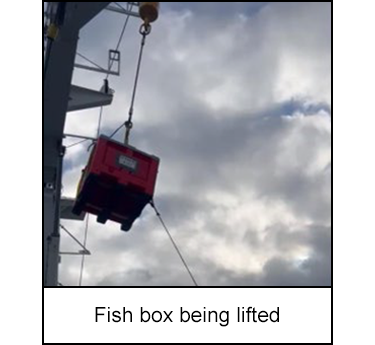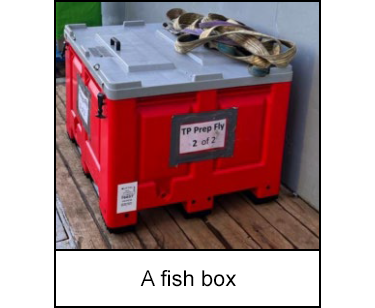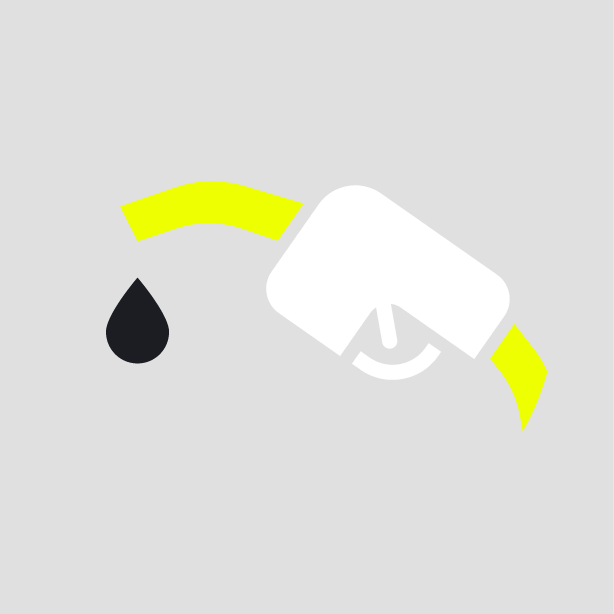-
What happened?
A near miss occurred on the external work platform (EWP) during the lifting operation of a fish box (see pictures) from the vessel, weighing approximately 350kgs (772lbs).
When the load was slewed outboard, it was subjected to a significant, unexpected swinging movement.
Despite the potentially unsafe situation caused by the unexpected gusts that led to a swinging load, the lifting operation continued until the fish box had been landed on the EWP.
The weather conditions at the time were within limits, with wind speeds of 10m/s (22mph) and gusts of 14m/s (31mph), both below the crane’s maximum operating wind speed of 16m/s (36mph).
Immediate actions taken:
- A stop work authority was issued upon notification of the incident.
- A safety stand down was held on the vessel with all persons onboard.
- Emphasis was placed on the stop work process with those involved in lifting operations, encouraging them to speak up and stop the task if deemed unsafe.
- The pre-job toolbox talks will consider current and predicted weather prior to any lifting operations.
- A review of the competence of those involved in the operations was conducted.
- Each lift to be reviewed considering variables such as weight of load, centre of gravity, complexity of lift and weather conditions at the time. No two lifts are the same and regardless of weather conditions if the lift is deemed unsafe the stop work authority shall be issued and the task stopped and load to be made safe.

-
Why did it happen?
Stop work authority was not used at the time of the incident.
Low hazard and risk perception was evident for those involved in the incident.
Inadequate assessment of operational working limits and risks associated with weather conditions and the load's characteristics (weight, size, shape, centre of gravity) contributed to the incident.
This was one of the first lifts carried out by the team following the mobilisation of a new vessel offshore on the project.
There was no positive reinforcement of stop work authority process, which may have led to those involved not raising the incident due to fear of reprisals.

-
What did they learn?
Use stop work authority immediately if you observe significant movement of the load. If needed, halt the operation and return the load to the service operations vessel (SOV) to allow for a reassessment of weather conditions and wait for improvement.
Take into account the weight, size, shape, and centre of gravity of the load before beginning any lift. Even if weather conditions are within limits, these factors can contribute to unexpected swinging or movement.
Verify that an authority to work (ATW) has been issued and understood for the task you’re involved in, ensuring all conditions are clear before beginning.
Participate in safety stand downs and actively engage in discussions about incident details with everyone onboard. Review available weather forecasts, to stay informed of current and predicted conditions.
Ensure your own competence and confirm that you are fully trained for the tasks you’re undertaking. This applies especially to those operating cranes and rigging equipment.
Follow lifting procedures carefully and be aware of the maximum operating weather conditions for your tasks.
Support full incident investigations by providing accurate accounts and insights, and review the issued reports and safety alerts to learn from any incidents.
Remember to use stop work authority whenever needed. If you believe a lift is unsafe, speak up and halt the task until conditions are confirmed to be secure.

-
Ask yourself or your crew
How can you ensure that the weight, size, shape, and centre of gravity of each load has been assessed to anticipate and manage potential movement during lifts?
What can you do to feel more confident using stop work authority when conditions seem unsafe, and how can you encourage others to use it too?
What approaches can we take as a team to improve our awareness and response to changing environmental conditions during lifting operations?
How can we enhance our procedures and communication to ensure that each lift is safely conducted, even when conditions appear within operational limits?

Add to homescreen
Content name
Select existing category:
Content name
New collection
Edit collection
What happened?
A near miss occurred on the external work platform (EWP) during the lifting operation of a fish box (see pictures) from the vessel, weighing approximately 350kgs (772lbs).
When the load was slewed outboard, it was subjected to a significant, unexpected swinging movement.
Despite the potentially unsafe situation caused by the unexpected gusts that led to a swinging load, the lifting operation continued until the fish box had been landed on the EWP.
The weather conditions at the time were within limits, with wind speeds of 10m/s (22mph) and gusts of 14m/s (31mph), both below the crane’s maximum operating wind speed of 16m/s (36mph).
Immediate actions taken:
- A stop work authority was issued upon notification of the incident.
- A safety stand down was held on the vessel with all persons onboard.
- Emphasis was placed on the stop work process with those involved in lifting operations, encouraging them to speak up and stop the task if deemed unsafe.
- The pre-job toolbox talks will consider current and predicted weather prior to any lifting operations.
- A review of the competence of those involved in the operations was conducted.
- Each lift to be reviewed considering variables such as weight of load, centre of gravity, complexity of lift and weather conditions at the time. No two lifts are the same and regardless of weather conditions if the lift is deemed unsafe the stop work authority shall be issued and the task stopped and load to be made safe.

Why did it happen?
Stop work authority was not used at the time of the incident.
Low hazard and risk perception was evident for those involved in the incident.
Inadequate assessment of operational working limits and risks associated with weather conditions and the load's characteristics (weight, size, shape, centre of gravity) contributed to the incident.
This was one of the first lifts carried out by the team following the mobilisation of a new vessel offshore on the project.
There was no positive reinforcement of stop work authority process, which may have led to those involved not raising the incident due to fear of reprisals.

What did they learn?
Use stop work authority immediately if you observe significant movement of the load. If needed, halt the operation and return the load to the service operations vessel (SOV) to allow for a reassessment of weather conditions and wait for improvement.
Take into account the weight, size, shape, and centre of gravity of the load before beginning any lift. Even if weather conditions are within limits, these factors can contribute to unexpected swinging or movement.
Verify that an authority to work (ATW) has been issued and understood for the task you’re involved in, ensuring all conditions are clear before beginning.
Participate in safety stand downs and actively engage in discussions about incident details with everyone onboard. Review available weather forecasts, to stay informed of current and predicted conditions.
Ensure your own competence and confirm that you are fully trained for the tasks you’re undertaking. This applies especially to those operating cranes and rigging equipment.
Follow lifting procedures carefully and be aware of the maximum operating weather conditions for your tasks.
Support full incident investigations by providing accurate accounts and insights, and review the issued reports and safety alerts to learn from any incidents.
Remember to use stop work authority whenever needed. If you believe a lift is unsafe, speak up and halt the task until conditions are confirmed to be secure.
Ask yourself or your crew
How can you ensure that the weight, size, shape, and centre of gravity of each load has been assessed to anticipate and manage potential movement during lifts?
What can you do to feel more confident using stop work authority when conditions seem unsafe, and how can you encourage others to use it too?
What approaches can we take as a team to improve our awareness and response to changing environmental conditions during lifting operations?
How can we enhance our procedures and communication to ensure that each lift is safely conducted, even when conditions appear within operational limits?
A near miss occurred during a lifting operation on the external work platform when a 350kg (772lbs) fish box unexpectedly swung due to gusts of wind. Despite the unsafe situation, the operation continued until the load was safely landed, prompting a stop work authority and a safety stand down to review procedures and emphasise the importance of stopping work if conditions are unsafe.












